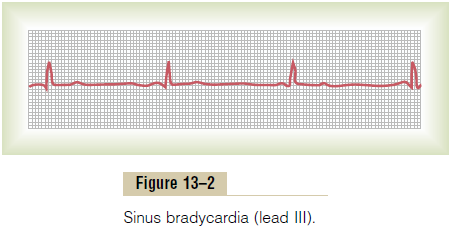Chapter: Medical Physiology: Cardiac Arrhythmias and Their Electrocardiographic Interpretation
Bradycardia - Abnormal Sinus Rhythms
Bradycardia
The term “bradycardia” means a slow heart rate, usually defined as fewer than 60 beats per minute. Bradycardia is shown by the electrocardiogram in Figure 13–2.
Bradycardia in Athletes. The athlete’s heart is larger and considerably stronger thanthat of a normal person, which allows the athlete’s heart to pump a large stroke volume output per beat even during periods of rest. When the athlete is at rest, excessive quantities of blood pumped into the arterial tree with each beat initiate feedback circulatory reflexes or other effects to cause bradycardia.

Vagal Stimulation as a Cause of Bradycardia. Any circulatoryreflex that stimulates the vagus nerves causes release of acetylcholine at the vagal endings in the heart, thus giving a parasympathetic effect. Perhaps the most strik-ing example of this occurs in patients with carotid sinussyndrome. In these patients, the pressure receptors(baroreceptors) in the carotid sinus region of the carotid artery walls are excessively sensitive. Therefore, even mild external pressure on the neck elicits a strong baroreceptor reflex, causing intense vagal-acetylcholine effects on the heart, including extreme bradycardia. Indeed, sometimes this reflex is so powerful that it actu-ally stops the heart for 5 to 10 seconds.
Related Topics